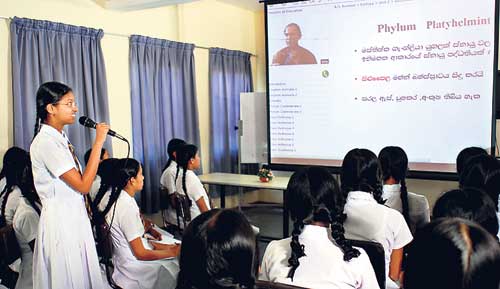
Dialog Telekom takes teaching rural students to new level
How many of society’s real problems can technology solve? For many of the people outside the perimeters of Colombo city, life revolves more around how to manage food expenses or educate children than which new phone to buy or how to increase the number of channels on your satellite TV. “We wanted to provide connectivity to children through Broadband,” says Michael De Silva, Senior Manager, Public Policy and Corporate Responsibility of Dialog Telekom PLC, speaking of Dialog’s CSR initiative which attempts to bridge the digital divide. The project for which Dialog has set apart Rs.100 million for its first phase will involve Dialog Broadcasting educational programmes via satellite to the more remote regions of the country. The programmes will be aired via a channel on Dialog TV named ‘Nenasa’ which will be devoted entirely to this. They hope to cover the G.C.E. O/Level and A/level syllabi through these programmes. The venture is in partnership with the Ministry of Education and the National Education Institute. While Dialog will be handling the technical side by supplying the schools with the satellite dishes, TV sets and projectors, the other two partners will be looking into the content of the programmes as well as the recording element. “We want to take good teaching to the areas which are rural and deprived of education,” said De Silva adding that Dialog conducted a pilot in 2007 to observe the success of the programme. According to De Silva, the pilot was conducted through Broadband, and not satellite TV. However, using Broadband to transmit education proved to be slightly arduous, he says. Not only did it limit the recipients to only schools with Internet connectivity and computers, but the rural students were also slow to adapt to the technique, testament to the low IT penetration outside of the major cities. This led to the team considering satellite TV to be a better option. “As long as they can see the sky, they can be connected to this,” he says. As a supplement to the TV programmes, a Learning Management system will also be placed. The LMS will be a repository of the information broadcasted, “Students will be able to go back to the information they watched on the computer, it will be available on Excel and PowerPoint formats,” said De Silva. Dialog will be providing TV sets and satellite dishes to 900 schools and satellite dishes and projectors with screens to 100 schools, in an attempt to check if the TV alone is effective enough or if the programmes need to be projected to a wider area. According to De Silva, the projectors are more expensive and also have shorter life spans. Some 200,000 students are expected to be the beneficiaries of the project. In Phase 1 of the project, he says they will concentrate on finishing only the recording of G.C.E. O/ Level syllabus by the end of this year. “We don’t want to replace the teachers but simply enhance the teaching experience,” said De Silva. The teachers who will do the recordings will be chosen by the Ministry of Education. According to Douglas Ranasinghe, Additional Commissioner from the Ministry of Education, the NIE already has a resource pool of teachers since they regularly record educational programmes but letters have also been sent to most of the leading schools in Colombo-both public and private- asking the principals to suggest teachers who can be used. Choosing the schools that will benefit is also up to the Ministry. “The Ministry picks them out on certain criteria: The schools must have electricity; Grade 11 has to have more than 15 students; the schools have to be ones which the Ministry finds difficult to outsource teachers to because of conflict and other issues; and they have to be able to afford some security to the equipment we send,” said Ranasinghe. The NIE studios are equipped for the recording and the staff members there are old hands at it. The programmes themselves are interesting and innovative. The Social/Geography studies lessons include a number of shots of actual geographical locations and geo features from various parts of the island. The Maths lessons try teaching tough Geometry using animation. While some of the lessons are simply voice-overs with images, others involve teachers, sometime in the studio, sometimes on-site. The project officials say that the Phase 1 will mainly feature in-studio teachers. “First we will be teaching Maths, Science, English, Sinhalese and Tamil (As a first language),” said NIE Deputy Director General, Gunaratne Banda. The teachers are being educated on script-writing by the NIE. The scripts by the teacher will be checked by the curriculum developers at the NIE. Also, according to him, the NIE is hoping to get the help of international scholar channels like National Geographic, The Museum channel and the History channel. Copyright issues will not arise as long as the NIE only borrows the images, according to him The pilot by Dialog was carried out in the Hambantota and Kandy districts. According to De Silva, the response by the students themselves was positive, “They were very positive,” he said. While the project allows Dialog to carry out its corporate service, it will also be a chance for the Ministry to improve on the increasingly dismal O/level results of the past few years, Ranasinghe confirmed. |
|
||||||
|
||||||
| || Front
Page | News
| Editorial
| Columns
| Sports
| Plus
| Financial
Times | International
| Mirror
| TV
Times | Funday Times || |
| |
Reproduction of articles permitted when used without any alterations to contents and a link to the source page.
|
© Copyright
2008 | Wijeya
Newspapers Ltd.Colombo. Sri Lanka. All Rights Reserved. |
